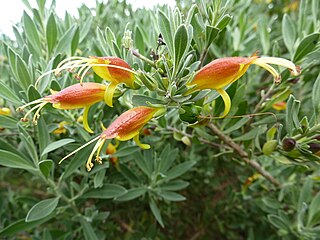
Eremophila glabra, commonly known as tar bush, is a plant in the figwort family, Scrophulariaceae and is endemic to Australia. It is sometimes a low, ground-hugging and sometimes an erect shrub. The leaves are variable in size and shape and there is a range of flower colours. In spite of its scientific name, not all forms of the plant are glabrous but most have many small, raised glands on the stems, flowers and leaves.

Eremophila oldfieldii, commonly known as pixie bush, is a flowering plant in the figwort family, Scrophulariaceae and is endemic to Western Australia. It is a shrub or small tree with rough bark, broad, flat or narrow fleshy leaves and red, orange or yellow flowers.

Eremophila deserti is a shrub which is endemic to Australia. Common names for this species include turkey bush, dogwood, poison bushEllangowan poison bush, pencil bush and carrot bush. It is common and widespread in all mainland states, although not the Northern Territory. Some forms are poisonous to stock.

Grevillea integrifolia, commonly known as entire-leaved grevillea, is a species of flowering plant in the family Proteaceae and is endemic to the south-west of Western Australia. It is an erect shrub with egg-shaped leaves, the narrower end towards the base, and cylindrical clusters of white to creamy-white flowers.
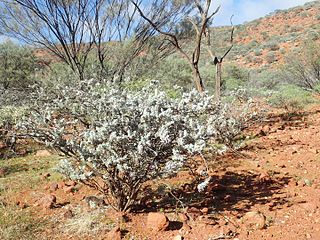
Eremophila conferta is a flowering plant in the figwort family, Scrophulariaceae and is endemic to a small area in the central west of Western Australia. It is a shrub with many tangled branches with leaves crowded near their ends and with mauve or purple flowers.

Eremophila lehmanniana is a flowering plant in the figwort family, Scrophulariaceae and is endemic to Western Australia. It is an erect shrub, usually with short, wide, serrated leaves and white to lilac-coloured flowers. It occurs in the south west of Western Australia.
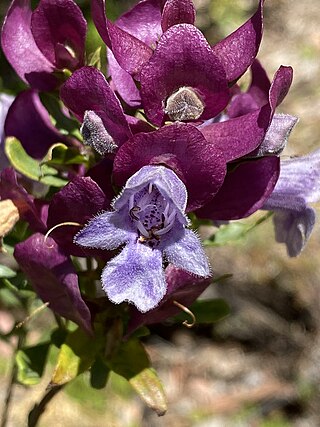
Eremophila magnifica is a flowering plant in the figwort family, Scrophulariaceae and is endemic to Western Australia. It is an erect shrub with large, clustered leaves and large, attractive lilac-coloured or purple flowers, sometimes so densely clustered that they appear like compound heads of terminal flowers.

Eremophila phyllopoda is a flowering plant in the figwort family, Scrophulariaceae and is endemic to Western Australia. It is an erect or spreading shrub, sometimes round or flat-topped with sticky, hairy leaves and flowers ranging in colour from pink or lilac to purple.
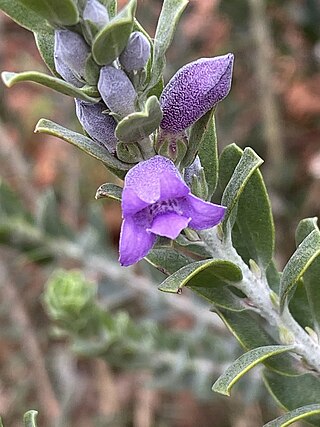
Eremophila resinosa, also known as resinous eremophila, is a flowering plant in the figwort family, Scrophulariaceae and is endemic to Western Australia. It is a spreading shrub with sticky young foliage, short leaves, small sepals and mauve, purple or sometimes white flowers.

Eremophila serpens, commonly known as snake eremophila, is a flowering plant in the figwort family, Scrophulariaceae and is endemic to Western Australia. It is a prostrate, creeping shrub with long, horizontal branches, leaves which often have irregular serrations, and yellowish-green petals with red or brownish-purple markings.

Eremophila serrulata, commonly known as serrate-leaved eremophila, is a flowering plant in the figwort family, Scrophulariaceae and is endemic to Australia. It is an erect or spreading shrub whose leaves are sticky and have small serrations, and flowers that have green, yellowish-green or yellowish-brown petals.
Eremophila shonae is a flowering plant in the figwort family, Scrophulariaceae and is endemic to Western Australia. It is an erect shrub or a low spreading shrub, depending on subspecies and has very sticky branches and leaves due to the presence of large amounts of resin. The leaves are narrow and the flowers are mauve to purple and white inside with purple spots.

Eremophila spectabilis, commonly known as showy poverty bush, is a flowering plant in the figwort family, Scrophulariaceae and is endemic to Western Australia. It is a dense, erect shrub with narrow, greyish leaves and blue, mauve or purple flowers.

Eremophila spuria is a flowering plant in the figwort family, Scrophulariaceae and is endemic to Western Australia. It is an erect, open shrub with narrow leaves and blue, lilac, purple or white flowers and is a common and widespread species.

Eremophila viscida, commonly known as varnish bush, is a flowering plant in the figwort family, Scrophulariaceae and is endemic to Western Australia. It is a large shrub or small tree with large green leaves which are sticky when young, colourful sepals and greenish-white petals with red to purple markings.

Verticordia grandiflora, commonly known as claw featherflower, clawed featherflower or horned featherflower, is a flowering plant in the myrtle family Myrtaceae, and is endemic to the south-west of Western Australia. It is a small, rigid shrub with many short side-branches, mostly linear leaves and heads of yellow flowers which soon age to reddish but which are among the largest in the genus. It is similar in appearance to several other species of verticordias with which it is often confused.

Darwinia purpurea, commonly known as the rose darwinia, is a species of flowering plant in the family Myrtaceae and is endemic to the southwest of Western Australia. It is a spreading shrub with linear leaves and dense heads of red or yellow flowers surrounded by many overlapping involucral bracts.

Conospermum huegelii, commonly known as the slender smokebush, is a plant endemic to Western Australia.
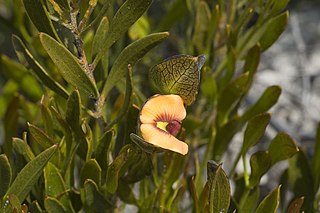
Daviesia alternifolia is a species of flowering plant in the family Fabaceae and is endemic to the south-west of Western Australia. It is a dense, spreading shrub with scattered, egg-shaped phyllodes with the narrower end towards the base, and orange and red flowers with a greenish-yellow centre.

Daviesia oppositifolia, commonly known as rattle-pea, is a species of flowering plant in the family Fabaceae and is endemic to the south-west of Western Australia. It is an erect shrub with many stems, egg-shaped phyllodes with the narrower end towards the base, and yellow flowers with maroon markings.




















